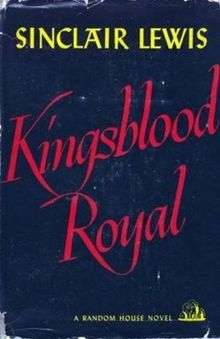Kingsblood Royal
 Cover of the first edition | |
| Author | Sinclair Lewis |
|---|---|
| Country | United States |
| Language | English |
| Subject | Racial discrimination |
| Genre | Satire |
| Publisher | Random House |
Publication date | 1947 |
Kingsblood Royal is a 1947 novel by American writer Sinclair Lewis.
Synopsis
The protagonist, Neil Kingsblood, a white middle-class man, discovers while researching his family background that he is directly descended from an African adventurer on the American frontier. (His ancestor is loosely modeled after Pierre Bonga, an African American who worked as a fur trapper for the North West Company.)[1]
Through various machinations, Kingsblood loses his banking job and takes a lesser one. He begins to be treated differently by former acquaintances, despite the lack of visible African ancestry. He is forced to choose between continuing what he has come to see as a hollow existence in the white community and taking on the oppressed minority status of the black community.
After Kingsblood tells several white friends about his newfound ancestry, the news quickly spreads, and he finds that acquaintances change their behavior toward him. He engages in a quixotic struggle against the racism newly apparent but widespread in his community.
Because Royal is now black, it is illegal for him and his family to live in their home, which is in a whites only neighborhood. In the climactic scene, which is based on the real life Ossian Sweet incident which occurred in Detroit in 1925, a mob of their former neighbors comes to force the Royals out. The sense of helplessness against massive injustice is broken only by the final line of the work, which offers hope for the future.
Background
Sinclair Lewis met Walter Francis White, president of the NAACP and a man of majority European ancestry, and many of his professional circles. A number among them were persons of clearly European and African ancestry, composing the educated elites of black society. Given their visible and in some cases majority European ancestry, some had relatives or friends who had chosen to live as white based on appearance. Lewis consulted with White on the novel and was helped to meet numerous of his professional acquaintances; he learned about some contemporary issues of skin color and class within the black community.
Reception
While some white critics found the novel contrived, Ebony, a prominent African-American magazine, ranked it as the most important novel of the year. "The white establishment tended to view the novel as wildly implausible. Black people viewed it as profoundly perceptive."[2]
Shortly after the publication of Kingsblood Royal, a group of white supremacists sent a letter to J. Edgar Hoover encouraging the FBI to seize all copies of the book and declare Lewis' novel an act of sedition.[3]
Citations
- ↑ William Sherman Savage, Blacks in the West, Greenwood Publishing Group, 1976, pp. 68-70
- ↑ Brent Staples, " 'Kingsblood Royal': When the Bard of Main Street Turned the Kingsbloods Black", The New York Times, 18 Aug 2002, accessed 12 Apr 2008
- ↑ Lingeman, 513
Sources
- Robert Fleming, "Kingsblood Royal and the Black 'Passing' Novel" in Critical Essays on Sinclair Lewis, editor Martin Bucco (Boston: G. K. Hall & Company, 1986)
- Richard Lingeman, Sinclair Lewis: Rebel from Main Street (New York: Random House, 2002)
- Mark Schorer, Sinclair Lewis: An American Life (New York: McGraw-Hill, 1961)
External links
- Kingsblood Royal at Faded Page (Canada)
- Brent Staples, "When the Bard of Main Street Turned the Kingsbloods Black"